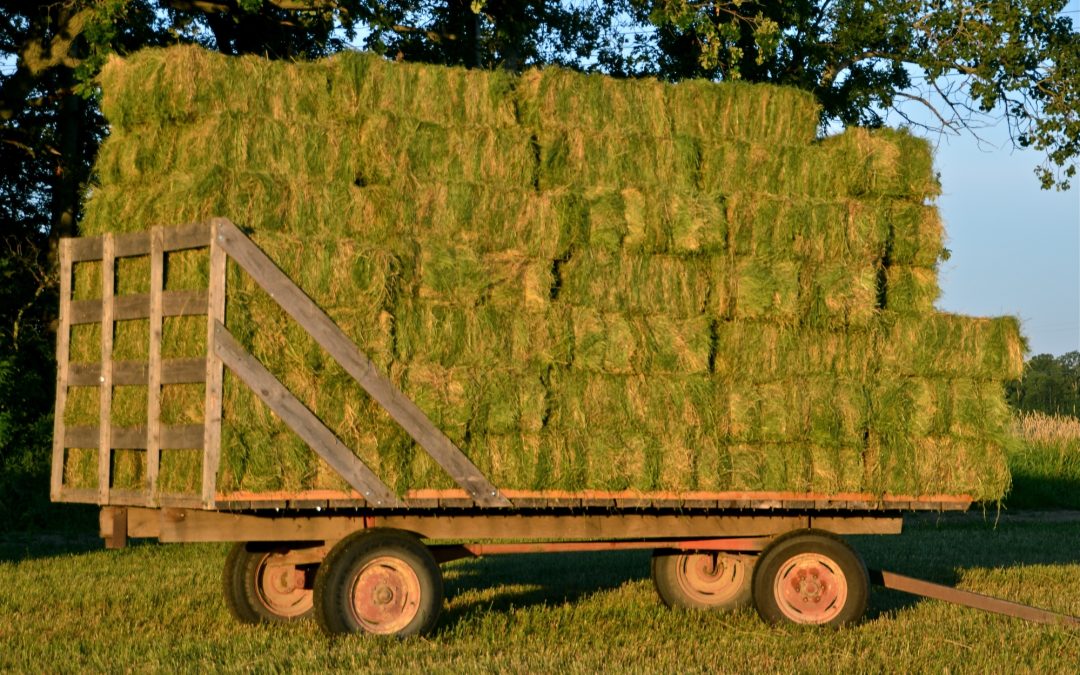For horses, the sweet smell and green, leafy look of alfalfa is hard to resist. While horses love the taste of this forage, it often comes with a variety of myths and misconceptions that lead horse owners to underutilize this valuable forage in their horse’s diet. While alfalfa is usually fed as forage, it is also available in cubes and chopped form and is commonly included in pelleted concentrate rations and supplements. Adding alfalfa to your horse’s ration provides excellent-quality protein, digestible fiber, digestible energy (calories) and calcium.
Alfalfa as Forage
Also known as Lucerne in Europe, Australia, and New Zealand, alfalfa is a cool-season legume that grows to a height of up to three feet and can have a deep root system as wide as 15 feet. Due to an extensive root system, alfalfa is fairly resistant to drought conditions. Commonly grown in California, South Dakota, and Wisconsin, the upper Midwestern states produce about 50% of alfalfa output.
For nutritional quality, alfalfa has higher values for percentage of protein, digestible fiber, and digestible energy than grass forages such as timothy or orchardgrass. Because alfalfa has such high nutrient density, utilizing it in feed formulations is beneficial and ensures nutrient intake is easily obtained. In other words, often a higher quality feed can be fed in a smaller amount than a lesser quality feed. This is beneficial for the racehorse or any horse that requires large amounts of feed to meet nutrient requirements, as high-intensity training tends to make horses go off feed, making the nutrient density of the ration extremely important.
Utilizing Alfalfa in Your Horse’s Diet
As nutrient-dense forage, alfalfa is extremely useful in situations that require higher nutrient levels, such as:
Gestation
Gestating broodmares, for example, have increased requirements for all nutrients starting the eighth month of pregnancy and should be fed a diet that includes alfalfa. Feeding good-quality forage, including alfalfa hay or in the form of pellets, cubes, or with a ration that incorporates alfalfa meal, is the most natural way to help meet these requirements. Once lactation begins the mare’s requirements can nearly double and again, the best way to help supplement nutrients is through the use of this excellent-quality forage. Lactating mares will utilize the extra calories and calcium found in alfalfa to help produce high-quality milk for their foals.
Growth
Growth also requires nutrient intake levels beyond maintenance levels. Using alfalfa products as forage for young horses is very beneficial because it is much more digestible compared to grass hays. It is important to note that young horses do not have the full ability to ferment fiber until they are about a year old. Feeding higher insoluble fiber forages such as timothy or orchardgrass hay or poorer quality forage sources often results in “hay belly”. Therefore, feeding only highly digestible fiber such as alfalfa, clover, and beet pulp is recommended for the young, growing horse.
The higher protein level of alfalfa compared with grass hay will also help the young, growing horse develop muscle properly. Protein is not a contributing factor to developmental disorders. Imbalances in the nutrients of the ration as a whole and feeding too much starch in the diet has been shown to cause these problems.
The high calcium content of alfalfa is also beneficial to horses in training, as it helps to buffer stomach acid and thus reduce the risk of developing stomach ulcers. Additionally, young horses entering training have a higher calcium requirement than their pastured counterparts due to demineralization of bone as a result of confinement to a stall (and lack of sprinting exercises that force the bone to adapt through remodeling the bone). Feeding alfalfa as a forage as well as a component of the concentrate is an excellent way to help meet the elevated calcium requirement of these horses.
Geriatric
Geriatric horses can be a challenge to feed. Many become thin and underweight as they age. This occurs because the ability to digest, metabolize, and absorb nutrients out of the hindgut becomes reduced with advancing age. The energy density and highly digestible fiber in alfalfa make it a good choice for getting excellent-quality nutrition into the aged horse. The protein, calcium, and phosphorus in alfalfa are highly digestible and will help the older horse remain healthy and in good weight.
Take Home Message
Alfalfa is versatile, nutritious, safe, and palatable forage for horses. For situations that elevate nutrient requirements, such as gestation and growth, alfalfa is suitable forage to incorporate into the diet. If you are unsure about your horse’s nutrient requirements or need assistance in putting together a proper feeding program, feel free to contact equine nutritionist Dr. Amy Gill at [email protected] or 859-967-3307.
This blog post was originally posted on Tuesday, August 14th, 2012 at Equine Nutrition and Health Services Blog. Blog article was re-posted with permission from blog owner, all rights reserved.

